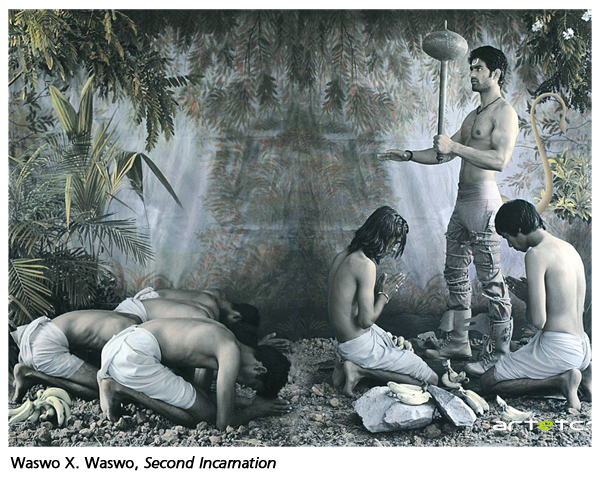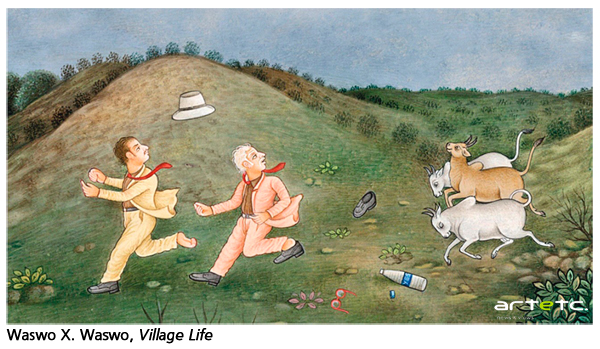- Publisher’s Note
- Editorial
- Progressive Artists Group of Bombay: An Overview
- S. H. Raza: The Modern
- Ara: The Uncommon Commoner
- Art of Francis Newton Souza:A Study in Psycho-Analytical Approach
- M.F. Husain: An Iconoclastic Icon
- Husain’s ‘Zameen’
- Life and Art of Sadanand Bakre
- Hari Ambadas Gade: Relocating the Silent Alleys
- Mysticism Yearning for the Absolute
- Modernist Art from India at Rubin Museum of Art, New York
- Traditional Art from India at the Peabody Essex Museum
- Nandan Mela 2011: A Fair with Flair
- India's First Online Auction of Antiquities
- The Market Masters
- Markets May Plunge and the Rich May Flock To Art
- What Happened and What's Forthcoming
- Random Strokes
- Julian Beever: Morphing Reality With Chalk Asthetics
- Eyes on Life: Reviewing Satish Gujral’s Recent Drawings
- Exploring Intimacy: Postcards of Nandalal Bose
- Irony as Form
- Strange Paradise
- Eyeball Massage: Pipilotti Rist
- René Lalique: A Genius of French Decorative Art
- The Milwaukee Art Museum – Poetry in Motion
- 9 Bäumleingasse
- Art Events Kolkata: November – December 2011
- Art Bengaluru
- Mumbai Art Sighting
- Delhi Dais
- Tacita Dean at Turbine Hall, Tate Modern, London
- Preview: January, 2012 – February, 2012
- In the News: December 2011
ART news & views
Irony as Form
Issue No: 24 Month: 1 Year: 2012
Review
by Dr. Seema Bawa

New Delhi. Waswo X Waswo, an American photographer based in Udaipur recently held an exhibition Confessions of an Evil Orientalist at Gallerie Espace. The display is mixture of hand painted photographs, leather bound book covers, a comic book and miniatures and text-as image and text-as-word produced by the photographer and his Indian collaborators, Rajesh Soni and R. Vijay, who have painted the photos and the miniatures respectively.
The entire show focuses on the experiences and consequent conclusive ideas that the photographer-observer-‘participant’ derives from these. “I have made you into a cartoon that mirrors the cartoon of me” says the artist in one of his confessions. This confessions sums up the intentionality behind the mock-epic or burlesque of the of ‘white man’s burden’; a tongue in cheek self conscious Orientalism, which can in this age, find its appropriate depiction only in a comic-book reminiscent of the Indrajals of yore.
What comes across throughout the comic is the Banality of the contemporary Orientalist’s epos. This is evident in the faux spirituality, the homo-erotic appropriation and ‘eye-dealisation’ of the brown male and the reduction through the lens of the camera of the complex raga that is India to a single dimension monody. The persona of the rationalist observer never graduates to an actual observer-participant; rationality and cultural baggage remains the idiot questioner of all the experiences without any genuine receptivity. The self conscious persona of the comic acknowledges this under the trope “evil”. The depiction is thus interesting as it lends itself to various layers of interpretation.
 The evil Orientalist here is a post colonial settler who has an image of the ‘Orient’ that he cherishes: the ‘simple Indian villages’, the women in paddy fields, the landscape; despite the underlying awareness of the inevitable change and his own inability to integrate. The image of the Asiatic as changeless and perpetual is a myth that still persists in the western imagination. “I have never considered living as you do, but expect you to continue living that way yourself,” he confesses.
The evil Orientalist here is a post colonial settler who has an image of the ‘Orient’ that he cherishes: the ‘simple Indian villages’, the women in paddy fields, the landscape; despite the underlying awareness of the inevitable change and his own inability to integrate. The image of the Asiatic as changeless and perpetual is a myth that still persists in the western imagination. “I have never considered living as you do, but expect you to continue living that way yourself,” he confesses.
As the protagonist in the comic, he also dialogues with Indian art including Amrita Shergil and India’s own elite ‘orienatalism’. Then there is the Self Portrait of Manjit Bawa commenting that his fellow traveler seems quiet lost in his quest for spiritualism.
The relationship with early Orientalist artists such as the Daniel brothers and Tilly Kettle comes through the painted backdrops of the photographs. The wild and the exotic monuments and undergrowth can be seen in the rear in the Picnic, against which two women and a man with a goat eat fruit and even vegetables. Hills, monuments, vegetation dominate the backdrop within which sadhus, and local actors in Ram lila are posed. He does say “I have seen an orange moon above a blue village and thought it romantic.“ Landscape-real, mythical as well as calendar art aesthetic et-al are appropriated to the Orientalist’s vision at the same type reductionist, ironical, affectionate yet having a dialogic perspicacity that is stunningly fresh.
 Perhaps the most telling of all photographs is The Sankskrit Scholar, holding a long parchment in his hands. After almost all major Sanskrit texts ‘translated’ and published by the early European scholars were based on the knowledge of the pundits who actually read out and translated the texts for the benefit of the ‘sahibs’ who paid them a salary for the same. Thus the early Orientalism was ironically based on the labour and study by the ‘natives’ themselves. Of course European scholars did try to examine the eastern civilization under their rational and scientific lens and Waswo has created a very perceptive and witty photograph of this phenomenon. In one of the confessions he says “I have embroidered my stories to make myself appear more civilized and you more bizarre”. In Confessions of an Evil Orientalist Waswo himself, in a white suit and a fedora hat, is the protagonist and is shown four times examining Indian subject-samples through pseudo-scientific equipment used by old world ethnographers. Through a magnifying glass, measuring the head with calipers (one of the more popular nineteenth century theories on Aryan-Dravidian origins was based on the skull proportions) and a measuring pole used also in archeology. One of the Indians is posed as a hunch-back deviant being misunderstood by the investigator, another, a virile young man igniting the homoerotic impulses and the third a young man chatting on the phone oblivious of the cultural-ideological wars around him. The subject object dichotomy is expressed through the dialoguing observer-participant who ironically appears clueless of the context.
Perhaps the most telling of all photographs is The Sankskrit Scholar, holding a long parchment in his hands. After almost all major Sanskrit texts ‘translated’ and published by the early European scholars were based on the knowledge of the pundits who actually read out and translated the texts for the benefit of the ‘sahibs’ who paid them a salary for the same. Thus the early Orientalism was ironically based on the labour and study by the ‘natives’ themselves. Of course European scholars did try to examine the eastern civilization under their rational and scientific lens and Waswo has created a very perceptive and witty photograph of this phenomenon. In one of the confessions he says “I have embroidered my stories to make myself appear more civilized and you more bizarre”. In Confessions of an Evil Orientalist Waswo himself, in a white suit and a fedora hat, is the protagonist and is shown four times examining Indian subject-samples through pseudo-scientific equipment used by old world ethnographers. Through a magnifying glass, measuring the head with calipers (one of the more popular nineteenth century theories on Aryan-Dravidian origins was based on the skull proportions) and a measuring pole used also in archeology. One of the Indians is posed as a hunch-back deviant being misunderstood by the investigator, another, a virile young man igniting the homoerotic impulses and the third a young man chatting on the phone oblivious of the cultural-ideological wars around him. The subject object dichotomy is expressed through the dialoguing observer-participant who ironically appears clueless of the context.
The East is often seen as effeminate, weak and penetrative in Orientalism, languorous, sensual and still in contrast to the vigour and dynamism of the West. Many sexual fantasies, heterosexual and homosexual were constructed around this in nineteenth century literature and art. “I have looked upon your brown skin with lust” Waswo admits. In Waswo’s work, the homosexual fantasy and consumption is apparent in the miniatures that were painted by R Vijay, who presumably translated Waswo’s ideas in a naïve, traditional style. In Convergence the idyllic ‘Orient’ is expressed through the verdant landscape, the ‘spiritual’ through the sadhu and the erotic through the tryst with a pugree clad man, all of which form part of the documentation-photography agenda of the white man. The mundane is often introduced into the grander scheme such as through the urinating man in Peshab at Midnight when the lovers tryst under the moonlit sky is interrupted by the call of nature.
The image of the American as a Modern day Lakshmi, an ATM and gateway to a better life is quite interesting especially in the context of the current polemic with regards to FDI in retail being the redemption of the impoverished farmer.
Waswo also seeks redemption from his Orientalism through his confessions and his affection for this country. In the end he asserts: I have come to think I belong here. I have dared to call this home. I have come to think I have rights here.